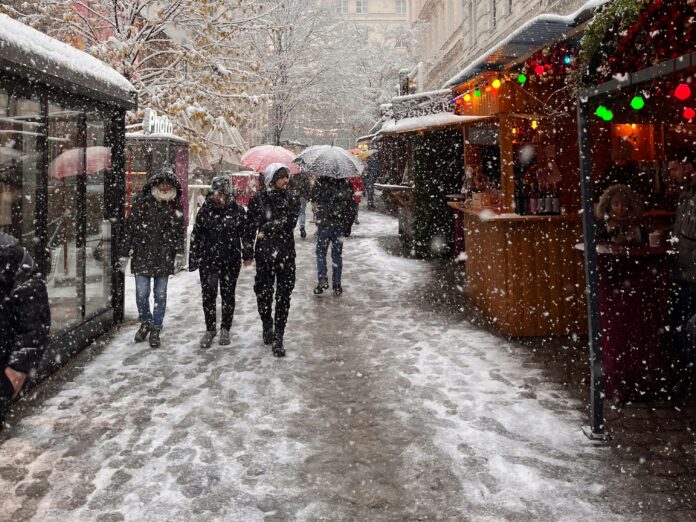A temporal rift, a misplaced enchantment, or perhaps simply a fortissimo played with too much passion—whatever the cause, Wolfgang Amadeus Mozart found himself not in 18th-century Vienna, but in the 21st, bewildered and standing before the glowing spectacle of the Christkindlmarkt at Rathausplatz. The Gothic spires of the City Hall were familiar, but the forest of wooden stalls, the twinkling lights, and the scent of spices were a new, intoxicating symphony for the senses.
A Punch of Pure Inspiration
His first instinct was to find a patron. His second was to investigate the source of the delicious aroma. He joined a queue, observing the strange, colorful paper people exchanged for goods. When he reached the front, he pointed at a steaming copper vat. He was handed a mug of Weihnachtspunsch and a small, colorful chip. He drank the punch in one gulp, the warmth of the rum and spices coursing through him. “Magnificent!” he exclaimed, pocketing the ceramic mug as a souvenir before a patient local explained the concept of a Pfand, a deposit for the mug. The sweet, spiced warmth was a sensation he vowed to capture in a new adagio.
A Sausage Serenade and a Strudel Scherzo
His stomach, accustomed to the lavish banquets of nobility, now growled in the presence of commoner fare. He approached a stall and used a few modern Euro coins he had “acquired” from a distracted tourist to purchase a Bratwurst. He took a bite, the crisp snap of the casing and the savory meat bringing a tear to his eye. “This is a melody for the mouth!” he announced to no one in particular. It was far superior to the often-lukewarm, ornate dishes of his time.
For dessert, he discovered Apfelstrudel. The flaky pastry and warm, cinnamon-apple filling were a revelation. He scribbled a quick musical phrase on a napkin—a light, playful theme he thought perfectly suited the dessert. He was already imagining a new composition, “Eine Kleine Strudelmusik.”
The Ghost of Melodies Future
Drawn by the sound of music, he wandered to the Christmas Village at Belvedere Palace. But the music he heard was his own! A string quartet was playing the third movement of his “Eine Kleine Nachtmusik.” He stood, transfixed and slightly offended by the modern interpretation. As the final note hung in the air, the crowd erupted in applause. Mozart, confused by this public adoration for a simple serenade, bowed deeply. The audience, assuming he was a passionate, costumed enthusiast, applauded louder.
He then heard a young woman playing a hauntingly familiar melody on a hammered dulcimer. It was the main theme from his Piano Sonata No. 11 in A major, the one with the “Rondo alla Turca.” He approached her. “You play my piece with great feeling,” he said. She smiled, “Thanks! It’s by Mozart. He’s, like, the original rockstar.” Mozart puffed out his chest. “Indeed,” he replied, before asking where he could find this “Mozart” to pay his respects.
A Finale Under the Lights
As evening fell, he found himself on the Graben, walking beneath the breathtaking chandeliers of lights. The sheer scale of the illumination, the joy on the faces of the common people, and the abundance of art and music available to all moved him profoundly. This was not the Vienna he knew, a city of rigid class structures and fickle aristocrats. This was a city that celebrated beauty openly.
Sitting in a traditional Viennese coffee house with a final Melange, he realized his time here was ending. The world had not forgotten Wolfgang Amadeus Mozart; it had embraced him. He had come as a confused time-traveler, but he was leaving as a composer inspired. As he faded from the modern world, his hand closed around the ceramic mug in his pocket—a tangible proof of his adventure—and a new symphony, a “Symphonie Pittoresque du Marché de Noël,” began to form in his mind, a piece full of the warmth of punch, the joy of the people, and the glittering lights of a future Vienna.



